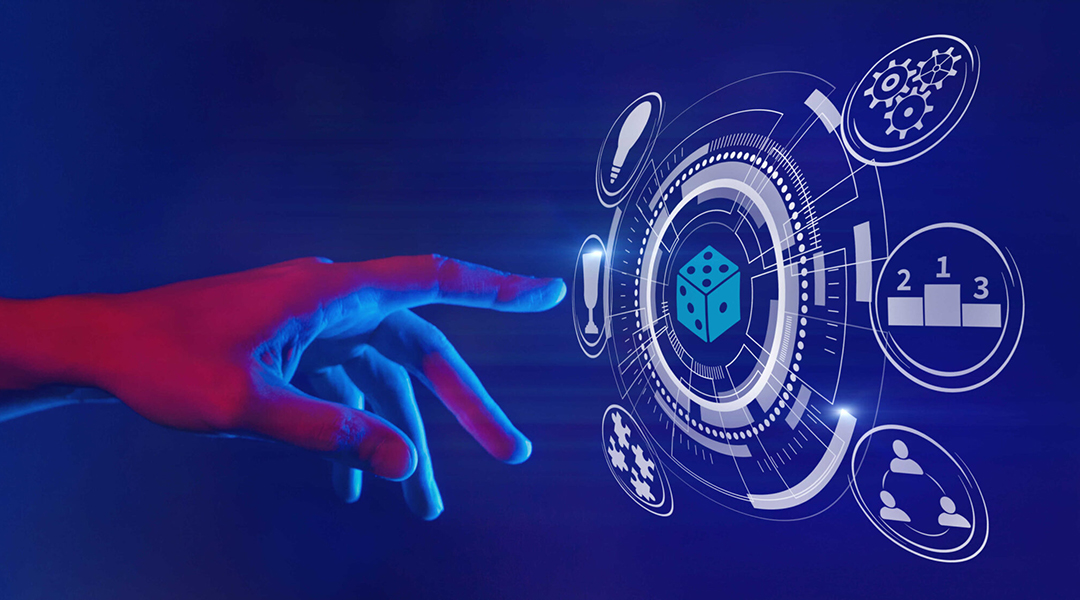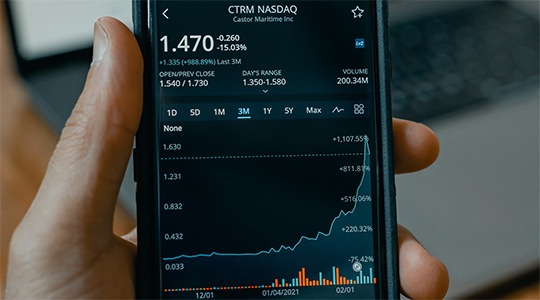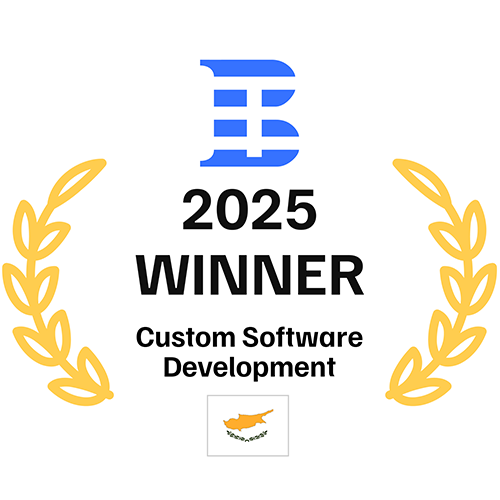Gamification has maintained a consistent level of global interest over the past two years, underscoring its growing significance in the business realm. This exploration delves into the essence of gamification, highlighting its key characteristics and the opportunities it presents. We examine how gamification development services for business can revolutionize the corporate landscape and significantly boost employee engagement levels.
At its core, gamification in business involves applying game-design elements and principles in non-game contexts, a strategy aimed at enhancing engagement, productivity, and overall motivation within the workplace. This approach, known as enterprise gamification solutions, tailors game mechanics to meet business objectives, fostering a more dynamic and interactive work environment.
Understanding "what is gamification" in business reveals its capacity to transform traditional business operations. It incorporates rewarding systems, challenges, and competitive elements that encourage participation and achievement among employees. Gamification strategies are not merely about injecting fun into the workplace but about leveraging intrinsic and extrinsic motivators to align employee activities with the company's goals.
The deployment of gamification strategies within a business setting requires careful planning and execution. By integrating these strategies, businesses can encourage behaviors that contribute to the company's success, such as increased sales performance, improved customer service, and more effective teamwork.
Furthermore, the adoption of gamification for business extends beyond employee engagement. It also plays a pivotal role in customer interaction and loyalty programs, where gamification techniques can enhance the customer experience, promote brand loyalty, and drive consumer behavior in desirable directions.
What is Gamification?
“Gamification is the process of using game thinking and game mechanics to engage audiences and solve problems”, says Gabe Zichermann at TedxKids@Brussels presentation.
To newcomers, "gamification" might initially present a puzzle, often misconceived as synonymous with mere gaming, evoking notions of leisure, amusement, and potential procrastination. Yet, gamification serves a distinctly different aim, particularly within the corporate sector.
It employs game mechanics and principles to elevate both intrinsic and extrinsic motivation among employees, thereby fostering a deeper engagement with their tasks. In the diverse and complex landscape of the corporate world, various gamification design models and solutions are strategically deployed to address specific business challenges.
“A game is about entertainment. Gamification is about accomplishing a business objective.” says Rajat Paharia, a founder of Bunchball.
Gamification for business introduces a groundbreaking shift away from conventional training methodologies, championing the use of serious games. These games are designed not just for entertainment but as a powerful tool for enhancing learning outcomes and facilitating professional growth. Our comprehensive whitepaper delves into how these interactive strategies can transform traditional approaches to training, offering a rich resource for anyone looking to understand the impact of gamification strategies in business contexts.
Moreover, the data generated from gamification in business scenarios provides invaluable insights into user behavior, preferences, and performance. This data-driven approach enables companies to refine their strategies continuously, ensuring they remain relevant and impactful. By analyzing engagement patterns, businesses can identify areas for improvement and innovation, further enhancing the effectiveness of their gamification initiatives.
Additionally, gamification introduces a competitive edge to learning and development programs. Leaderboards, points, and badge systems not only motivate employees by recognizing their achievements but also promote healthy competition that can lead to higher performance levels. The collaborative aspect of gamification strategies encourages teamwork and communication, which are vital components of a thriving organizational culture.
Adopting gamification in business is a testament to its effectiveness in engaging modern workforces and consumers. As companies continue to explore and expand upon these strategies, the potential for gamification to transform business operations and customer experiences is limitless. By partnering with experts in gamification, businesses can ensure they are leveraging these strategies to their fullest potential, driving growth, and fostering an environment of continuous learning and improvement.
Gamification Principles
Venturing further into the principles of gamification reveals its foundations deeply rooted in human psychology and behavioral science. As inherently social beings, humans universally crave gratification, respect, communication, and a sense of connection. We yearn for challenges and rewards, aspiring to one day look back with pride on our achievements, whether in life or within a specific organization.
Fortunately, the workplace often becomes a setting where many of these desires are fulfilled. In startup environments, for instance, the level of engagement frequently soars as each individual feels integrally connected to the projects at hand. Employees witness firsthand the outcomes of their efforts and the significant impact their work has on the organization's trajectory.
Conversely, within larger corporations, it's observed that employee engagement can diminish over time, often starting from a lower baseline. The clarity of one's contributions and their direct effects on company success can become obscured, leading to a muddled sense of direction. This lack of clear progress and recognition can foster frustration, demotivation, and even mental health challenges, adversely affecting a business's bottom line and overall growth.
This is where gamification for business becomes a pivotal strategy. By applying gamification strategies, companies can rekindle the enthusiasm and drive in their workforce. Gamification in business taps into these fundamental human needs, creating a work environment that mirrors the dynamics of startups by ensuring everyone feels valued and part of a larger mission. Through carefully crafted gamification strategies, businesses can simulate the sense of achievement and visibility of impact that motivates employees.
Employing gamification for business isn't merely about adding game elements to work processes; it's a sophisticated approach to enhancing employee satisfaction and retention. Gamification in business seeks to bridge the gap between the need for personal fulfillment and organizational objectives, thus cultivating a more motivated, engaged, and ultimately productive workforce. In doing so, gamification becomes more than a buzzword—it evolves into a critical component of a business's strategy for fostering a thriving, dynamic, and prosperous organizational culture.
Understanding Gamification Through A Gaming Experience
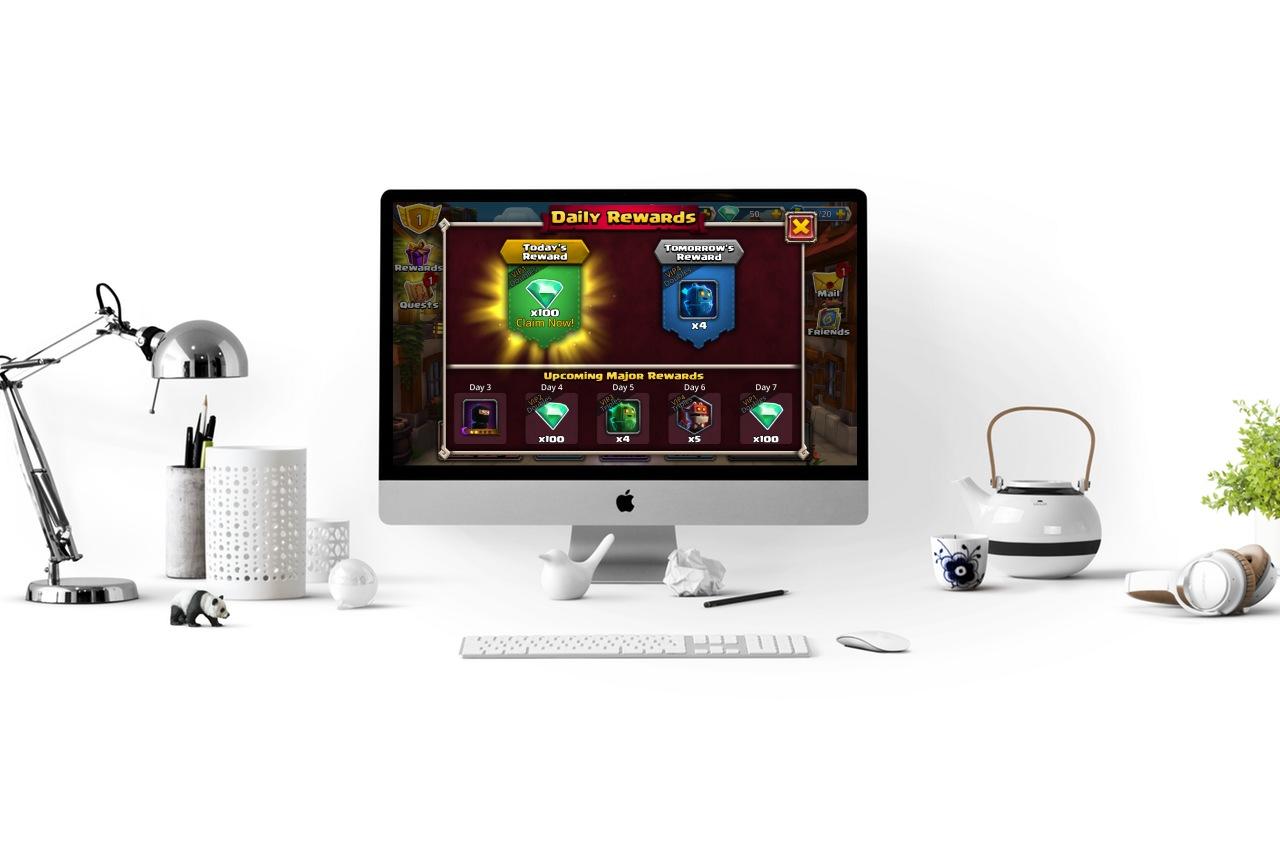
Business leaders and managers today often face challenges that game designers and developers have been addressing for decades. A well-crafted game is visually stunning, entertaining, richly rewarding, and deeply engaging. It unfolds a narrative that progresses as players navigate through various levels.
Missions are segmented into objectives, categorized as either short-term or long-term, presenting players with continuous challenges. The presence of a scoring system, along with bonuses, gifts, and other game mechanics, ensures immediate rewards upon achieving milestones. Player progress is meticulously tracked, allowing for reflection on past achievements. Accomplishments earn players in-game currency or points for skill enhancement, unlocking new levels, design features, character upgrades, and more.
The allure of a captivating game lies in its harmonious blend of storytelling, design, level progression, and a reward system, all engineered to guide players from one milestone to the next engagingly and enjoyably. Game designers play a crucial role in setting the game's tone and gameplay style, influencing desired player behaviors such as rapid, aggressive actions or calculated stealthy maneuvers.
When considering implementing gamification in business, the approach can be tailored to address specific organizational goals. For instance, if a development team is prone to overtime work, creating a custom application that incentivizes taking breaks could promote a healthier work-life balance. This strategy enhances the well-being of both the company and its employees.
The game World of Warcraft (WoW) reflects on reward-based systems and offers a notable example. Initially, to discourage prolonged gameplay, WoW's designers reduced the experience points for repetitive tasks, inadvertently penalizing players. Recognizing this, they shifted their strategy to offer rest bonuses, rewarding players for taking breaks with boosted stats upon their return. This adjustment by Blizzard masterfully illustrates the power of rewarding desired behaviors over penalizing unwanted ones, a principle that holds significant value in gamification for business.
This methodological shift underscores the effectiveness of gamification strategies in business environments, where engaging employees through a reward system can lead to improved productivity and satisfaction. Gamification in business, therefore, is not just about adding game elements to work processes but about fostering a motivated, engaged, and happy workforce through thoughtfully designed gamification strategies.
Gamification As an Employee Engagement Solution

Gamification addresses a broad spectrum of challenges within the corporate sector, offering practical solutions that enhance the operations and processes of Human Resources departments. The primary aim of HR is to boost a company's output by optimizing employee effectiveness. Key responsibilities of HR include:
- welcoming new employees to the company;
- acquainting them with its culture, mission, and objectives;
- facilitating their integration into the corporate environment and workflows;
- evaluating their performance in collaboration with their direct managers;
- organizing events to maintain high levels of engagement and motivation.
Despite the comprehensive responsibilities theoretically assigned to HR departments, a striking observation reveals that over 70% of employees feel disengaged at work. Picture the scene in any department: there's likely someone glancing at their phone or staring vacantly at their computer screen.
A subsequent check might reveal roles reversed, indicating a pervasive issue of motivation, both internally and externally. While influencing an individual's internal motivation presents challenges, external motivation can be significantly enhanced. Providing clear goals, monitoring progress, and acknowledging achievements can effectively stimulate the 16 basic human desires crucial for employee motivation.
The integration of gamification for business into HR strategies has shown promising results in tackling these motivational challenges. By adopting gamification strategies, businesses can create a more dynamic and engaging workplace. Gamification in business not only aids in clarifying objectives and monitoring their achievement but also plays a vital role in recognizing and rewarding employee efforts. This approach ensures that employees feel valued and understood, fostering a productive and motivated workforce.
In essence, gamification transforms traditional HR practices by injecting elements of play and competition, making routine tasks more engaging. This strategic implementation of gamification within business contexts has the power to reinvigorate the workplace, significantly reducing the number of disengaged employees and propelling the company toward greater success.
Gamification Examples
Gamification is the application of game elements to non-game contexts. And you already know that we love games because they have scoring systems, bonuses, and other things that lead to instant positive feedback about our progress. So, how do companies leverage gamification to improve trivial actions and make them more entertaining?
Business badges
Business.com showcases an exemplary model of website gamification through a dashboard feature within user accounts, highlighting the extent of their engagement within the community. This system meticulously records activities such as posting questions, endorsing preferred answers, sharing content, and responding to inquiries, subsequently awarding visually appealing badges to encourage continued interaction and contribution.
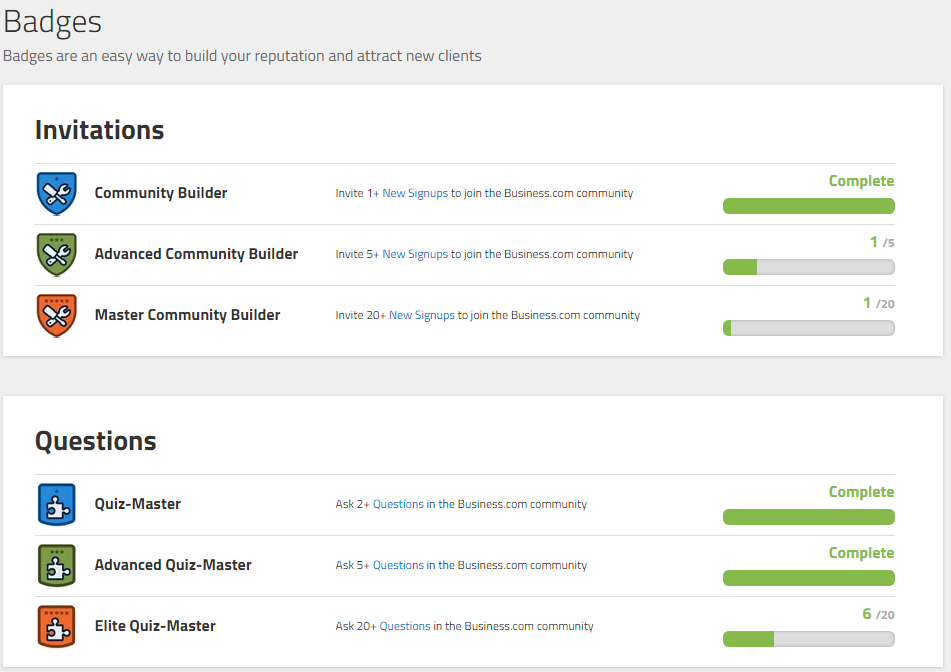
These badges not only serve to influence the user's experience positively but also enable other community members to assess one's level of participation swiftly. Furthermore, Business.com leverages this badge system as a mechanism for tracking user engagement, suggesting that an active and content-rich profile increases one's likelihood of being considered for a content contributor position on the platform.
Incorporating badges into a corporate setting presents a dynamic method for monitoring and rewarding employee achievements. This approach focuses on celebrating employees who efficiently complete tasks rather than penalizing those who may take longer. Such a strategy ensures that all team members are driven by the prospect of recognition and rewards, thereby cultivating a more productive and motivated workplace environment. Numerous businesses have embraced this gamification strategy, offering rewards such as additional vacation days, gym memberships, and various other perks to acknowledge and incentivize their most industrious employees.
This gamification for business not only exemplifies the practical application of gamification strategies but also underscores the transformative impact gamification can have within a business context. By integrating gamification into business processes, companies can foster a more engaging, rewarding, and ultimately productive work culture.
IQOS loyalty program
Philip Morris, a globally recognized tobacco firm, has introduced the "IQOS club," a customer loyalty scheme designed to boost purchases of IQOS products. This gamification initiative is structured around three tiers:
- Silver (0-1000 points)
- Gold (1000-3000 points)
- Platinum (3000+ points)
Membership levels within the IQOS club are determined by the accumulation of points awarded for engaging with various IQOS services, such as completing your profile and referring friends with promotional codes. These activities not only foster a sense of community among users but also allow them to earn points redeemable for specific gifts and advantages. Implementing gamification for business through a loyalty program is a strategic yet straightforward approach to enhancing customer engagement and retention.
This concept, though simple, is incredibly effective, as evidenced by the commonplace experience of accumulating points through everyday transactions, such as grocery shopping with a bonus card that offers discounts or the illusion of "free" purchases. Despite the reality that significant spending is required to redeem a relatively low-cost item, the psychological rewards include a sense of excitement and achievement.
The application of gamification in business extends beyond consumer markets into the workplace. For instance, employees might receive a month of complimentary taxi services and an attractive badge for successfully acquiring ten new clients. Similarly, long-term contributions to a company could be recognized with special awards and bonuses, marking milestones such as 1, 2, 5, or 10 years of service.
These gamification strategies introduce a layer of excitement and recognition into the corporate environment, proving that the principles of gamification can significantly influence both customer behavior and employee performance.
Farm Management System
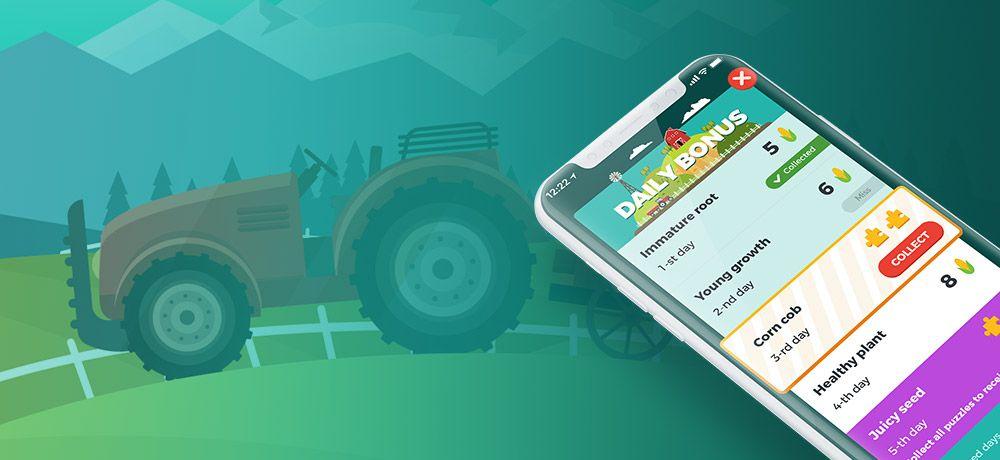
The Farm management system is an innovative application crafted by Program-Ace, designed to elevate employee engagement and training for a major Ukrainian agricultural enterprise. This initiative aimed to address several critical issues faced by the business, including excessive administrative costs and a noticeable lack of employee motivation. To confront these challenges head-on, a comprehensive problem analysis was conducted.
Prior to devising any gamification solutions, extensive consultancy efforts were made to identify and thoroughly document the underlying issues. Following this, a detailed specification document was developed and approved by the client, paving the way for the creation of a gamification app infused with diverse gaming mechanics aimed at resolving the identified problems. The app introduced several key features to enhance the workplace environment:
- Daily logins that motivate employees and managers to engage with the app regularly.
- Daily quests focused on executing farm management tasks effectively.
- Monthly achievements designed to monitor and celebrate employee progress and achievements.
- Seasonal challenges and events aimed at augmenting productivity among employees.
- A leaderboard, serving as a gamification dashboard, to display employee standings and advancements.
- Soft Currency Conversion, an inventive in-game monetary system that rewards employees with coins for their accomplishments, which can then be exchanged for actual currency.
Thanks to the utilization of Xamarin, a cross-platform development toolkit based on C#, the application boasts compatibility with both iOS and Android devices, ensuring widespread accessibility. Through the strategic implementation of gamification for business, this farm management system exemplifies how gamification in business can significantly enhance employee engagement and training. By leveraging gamification strategies, the app successfully addresses and mitigates business challenges, illustrating the profound impact gamification can have on operational efficiency and employee satisfaction.
Gamification Technology Stack
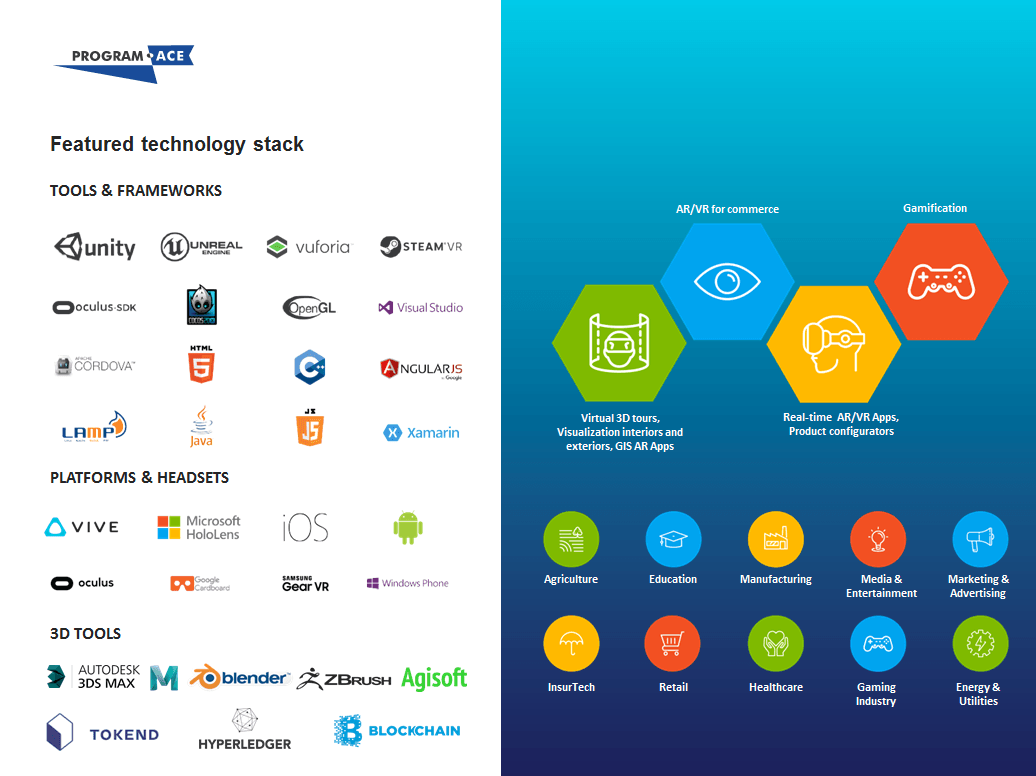
The technological framework required to create gamified applications largely mirrors standard apps, incorporating the same tools essential for application development. The choice of tools varies based on the application's intended platform, whether native, cross-platform, web, or desktop, offering a versatile toolkit for developers. This flexibility facilitates our ability to develop custom gamified applications across diverse sectors, harnessing the power of gamification for business enhancement.
Unity stands out as a robust game development engine, offering unparalleled versatility in crafting bespoke applications that swiftly and cost-effectively cater to varying degrees of complexity. Our previous discussions have compared Unity to Unreal Engine, particularly in the context of developing product configurators. Nevertheless, Unity's capabilities extend far beyond, making it an ideal choice for devising gamified apps tailored to specific business needs.
Businesses can unlock new dimensions of user engagement and interaction by employing gamification strategies within the development process. Gamification in business is not just about adding game elements to applications but about weaving a strategy that aligns with business objectives, enhancing user experience, and driving desired behaviors. This approach underscores the importance of selecting the right development engine, like Unity, which offers the flexibility and tools necessary to implement effective gamification strategies.
In summary, developing gamified applications requires a nuanced understanding of both the technological landscape and the principles of gamification. When companies decide to develop custom gamified applications, comparing engines like Unity to Unreal Engine becomes part of crafting a solution that is not only functional but also engaging. Through thoughtful application of gamification strategies, businesses can transform ordinary applications into powerful tools for user engagement and business growth.
Custom Gamification Solutions for Your Business with Program-Ace
Gamification transcends mere simplification of tasks for employees; its impact is profound, targeting the foundational elements of human psychology, cognition, and behavior. The creation of gamified applications is not aimed at entertainment but at facilitating the resolution of intricate work-related challenges, enhancing engagement, and refining decision-making processes in a manner that intertwines enjoyment with productivity.
This strategic blend of productivity and enjoyment through gamification encourages a more dynamic workplace, where tasks are perceived not as burdens but as opportunities for achievement and recognition. By aligning employee activities with gamified milestones and rewards, businesses can significantly increase intrinsic motivation, leading to a workforce that is more productive and more satisfied with their work.
Furthermore, gamification's role in promoting a positive company culture cannot be overstated. It creates an environment where employees feel valued and part of a greater mission, fostering loyalty and a sense of belonging. This approach to integrating gamification into the fabric of corporate operations exemplifies its potential to revolutionize traditional business models and employee engagement strategies, paving the way for innovative growth and development.
Why should your business consider partnering with Program-Ace? As a leading custom software development company, Program-Ace possesses the expertise and innovative approach necessary to design and implement gamification solutions that are custom-tailored to meet your unique business needs. Our seasoned team understands how to leverage gamification to foster a more motivated, engaged, and efficient workforce.
By choosing to collaborate with Program-Ace, you are not just investing in a gamification app — you are enhancing your organizational culture and operational efficiency. Our solutions are crafted to align with your strategic goals, ensuring that the gamification experience is seamlessly integrated into your business processes for maximum impact. So don’t hesitate for too long and just contact us.

